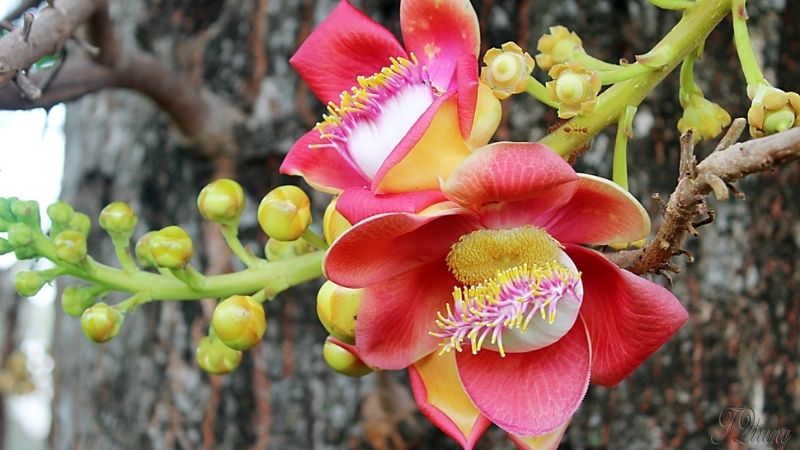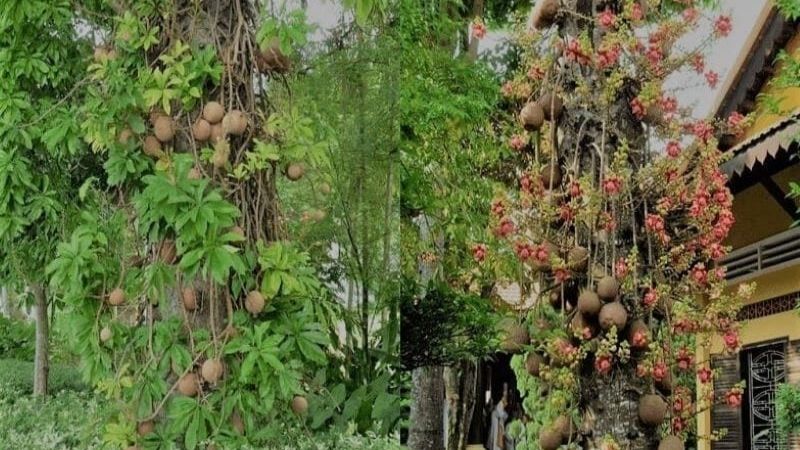The Sala tree is closely associated with the legend of Buddha Shakyamuni. Its vibrant red flowers, along with its many stories and symbolic meanings, have made it a popular choice for people to learn about and cultivate in their homes, creating a sense of tranquility. Let’s explore the significance and cultivation of the Sala tree together!
1 What is the Sala tree (Tha La tree)?
Origin and Significance of the Tha La Tree
The Sala tree, also known as the Ngoc Ky Lan, Dau Lan, or Uu Dam tree, has the scientific name Couroupita guianensis. It is native to South America and thrives in tropical climates such as the Amazon basin, the southern slopes of the Himalayas, and regions of Southeast Asia and South Asia.
Feng Shui Significance of the Tha La Tree
 Feng Shui significance of the Sala tree
Feng Shui significance of the Sala tree
The Sala tree is deeply connected to the image of Buddha Shakyamuni, hence its common presence in Buddhist temples. This tree embodies the purity and teachings of Buddhism. Even if the tree’s trunk appears gnarled and barren, its vibrant red flowers bloom profusely, filling the night air with a delightful fragrance.
Additionally, in Indian mythology, the Sala tree symbolizes a woman in love. It is believed that when the tree encounters love, it transforms into a radiant red flower, resembling a blushing maiden and exuding a sweet fragrance.
Characteristics and Classification of the Tha La Tree
The Sala tree is a large tree with a woody trunk that can grow to heights of 20-35 meters, depending on its age. Its flowers grow from the base of the tree, forming long clusters up to 3 meters in length, with a reddish-pink hue.
The Sala tree typically blooms from February to May, filling the night air with a refreshing fragrance. Its fruits are round and brown with a slightly rough texture, measuring about 14-25 cm in diameter and containing numerous seeds.
In Vietnam, the Sala tree is commonly cultivated in temples and Buddhist sites due to its rich symbolism and significance in Feng Shui.
 The Sala tree, also known as the Ngoc Ky Lan, Dau Lan, or Uu Dam tree
The Sala tree, also known as the Ngoc Ky Lan, Dau Lan, or Uu Dam tree
2 Benefits of the Sala tree (Tha La tree)
Health Benefits
Medicinal Properties
According to research, the Sala tree possesses antibacterial and antifungal properties and can be used to treat various ailments such as stomach aches, colds, and skin conditions like allergies and acne.
Refreshing Herbal Tea
Not only are the Sala tree’s flowers visually appealing, but they can also be used to make a refreshing herbal tea, offering a natural way to cool down during hot days.
Aesthetic Benefits
The Sala tree’s vibrant flowers add a touch of beauty and elegance to any living space, enhancing the overall ambiance.
 The Sala tree’s vibrant, colorful flowers
The Sala tree’s vibrant, colorful flowers
3 How to Grow and Care for the Sala tree (Tha La tree)
Growing the Tha La Tree at Home
When cultivating the Sala tree, it is essential to choose a location that receives ample sunlight and has good ventilation. However, due to its large canopy, it is advisable to avoid planting it directly in front of your house as it may impact the structure and Feng Shui of your home.
In terms of propagation, you can start with seeds, cuttings, or potted seedlings. If you opt for a potted seedling, remove the outer covering while retaining the soil around the roots. Prepare a hole about 20 cm deep in a well-ventilated area and place the seedling inside, adding a layer of loose soil mixed with chemical fertilizer at the bottom.
After planting, cover the seedling with soil, leaving about 1-2 cm of the stem exposed. Gently compact the soil around the plant to ensure its stability. With proper care, the tree can grow to a height of 3-5 meters in three years and will bloom with stunning red flowers after ten years.
 Seedling of the Sala tree
Seedling of the Sala tree
Caring for the Tha La Tree
Nutritional Requirements
The Sala tree does not require frequent fertilization. Applying fertilizer every two years is sufficient for its growth.
Watering Needs
For newly planted trees, daily watering is essential to prevent the soil from drying out and ensure the tree’s survival. Continue this regular watering routine as the tree matures.
Pest and Disease Control
In the first few years, the tree is susceptible to pests such as borers, leaf-eating insects, and brown planthoppers. Therefore, regular observation and spraying of pesticides are necessary to protect the tree from extensive damage.
 Caring for the Sala tree
Caring for the Sala tree
Notes on Growing and Caring for the Tha La Tree
-
The Sala tree thrives in sunny conditions, so plant it outdoors where it can receive ample natural light.
-
Due to its large canopy, avoid planting it directly in front of your house as it may affect the structure and Feng Shui of your home.
-
When purchasing a young tree, select a suitable type of soil for its growth.
-
Each tree has unique nutritional and water requirements, so be sure to follow specific care instructions for your tree.
4 5 Beautiful Images of the Sala tree (Tha La tree)
 The Sala tree, a large tree with a woody trunk, can grow up to 20-35 meters in height
The Sala tree, a large tree with a woody trunk, can grow up to 20-35 meters in height
 The Sala tree typically blooms from February to May
The Sala tree typically blooms from February to May
 The Sala tree, also known as the Ngoc Ky Lan, Dau Lan, or Uu Dam tree
The Sala tree, also known as the Ngoc Ky Lan, Dau Lan, or Uu Dam tree
 Scientific name: Couroupita guianensis
Scientific name: Couroupita guianensis
The information provided above offers a comprehensive guide to the Sala tree, including its significance, benefits, and cultivation techniques. We hope you found this information useful and inspiring!
2023 Lunar New Year Gift Ideas for Older Family and Friends
As 2021 approaches, families worldwide are gathering to celebrate the special bond between grandparents and their grandchildren. To show their love and admiration, these thoughtfully chosen gifts will bring a smile to the face of the elderly. Here, we have compiled a list of the 13 most meaningful Tet presents that can bring joy to our beloved grandparents.



































